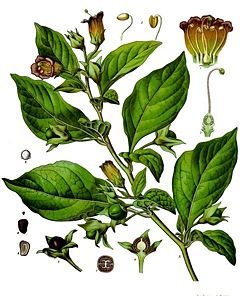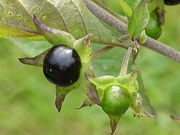Atropa belladonna
| Deadly nightshade | ||||||||||||||
|---|---|---|---|---|---|---|---|---|---|---|---|---|---|---|
 Illustration from Koehler's Medicinal Plants 1887
|
||||||||||||||
| Scientific classification | ||||||||||||||
|
||||||||||||||
| Binomial name | ||||||||||||||
| Atropa belladonna L. |
Atropa belladonna or Atropa bella-donna, commonly known as belladonna or deadly nightshade, is a perennial herbaceous plant in the family Solanaceae. The drug atropine is produced from the foliage, which along with the berries are extremely toxic, with hallucinogenic properties.
The species is native to Europe, North Africa, and Western Asia, and has become naturalized in parts of North America. In areas where it has become naturalized it can often be found in shady, moist areas with a limestone-rich soil. The name bella donna is derived from Italian and means "beautiful woman";[1] it was once used by women to enlarge the pupils of their eyes.[2]
Contents |
Description

Atropa belladonna is a branching herbaceous perennial, often growing as a subshrub, from a fleshy rootstock. Plants grow to 1.5 m (5 ft) tall with 18 cm (7 in) long ovate leaves. The bell-shaped flowers are dull purple with green tinges and faintly scented. The fruits are berries, which are green ripening to a shiny black, and approximately 1 cm in diameter. The berries are sweet and are consumed by animals that disperse the seeds in their droppings, even though the seeds contain toxic alkaloids. [3] There is a pale yellow flowering form called Atropa belladonna var. lutea with pale yellow fruit.
Atropa belladona is rarely used in gardens, but when grown it is usually for its large upright habit and showy berries.[4] It is considered a weed species in parts of the world,[5] where it colonizes areas with disturbed soils.[6] Germination of the small seeds is often difficult, due to hard seed coats that cause seed dormancy. Germination takes several weeks under alternating temperature conditions but can be sped up with the use of gibberellic acid.[7] The seedlings need sterile soil to prevent damping off and resent root disturbance during transplanting.
Naming and taxonomy
The first botanical description was by Linnaeus in Species Plantarum in 1753.[8] It is in the nightshade family (Solanaceae), which it shares with potatoes, tomatoes, eggplants, jimsonweed, tobacco, wolfberry, and chili peppers. The common names for this species include belladonna, deadly nightshade, dwale, banewort, devil's cherries, naughty man's cherries, divale, black cherry, devil's herb, great morel, and dwayberry.[9] It is one of two species to be known as deadly nightshade, the other is Solanum nigrum.
The name Atropa is thought to be derived from that of the Greek goddess Atropos, one of the three fates or destinies that would determine the course of a man's life by the weaving of threads that symbolized their birth, events in that life and finally their death; with Atropos cutting these threads to mark the latter.
Toxicity

Belladonna is one of the most toxic plants found in the Western hemisphere. All parts of the plant contain tropane alkaloids.[10] The berries pose the greatest danger to children because they look attractive and have a somewhat sweet taste.[9] The consumption of two to five berries by children and ten to twenty berries by adults can be lethal. The root of the plant is generally the most toxic part, though this can vary from one specimen to another. Ingestion of a single leaf of the plant can be fatal to an adult.[10]
The active agents in Belladonna, atropine, hyoscine (scopolamine), and hyoscyamine, have anticholinergic properties. The symptoms of belladonna poisoning include dilated pupils, sensitivity to light, blurred vision, tachycardia, loss of balance, staggering, headache, rash, flushing, dry mouth and throat, slurred speech, urinary retention, constipation, confusion, hallucinations, delirium, and convulsions.[11][12] The plant's deadly symptoms are caused by atropine's disruption of the parasympathetic nervous system's ability to regulate non-volitional/subconscious activities such as sweating, breathing, and heart rate. The antidote for belladonna poisoning is physostigmine or pilocarpine, the same as for atropine.[13] Atropa belladonna is also toxic to many domestic animals, causing narcosis and paralysis.[14] However, cattle and rabbits seem to eat the plant without suffering harmful effects.[12]
Uses
Cosmetics
The common name belladonna originates from its historic use by women - Bella Donna is Italian for beautiful lady. Drops prepared from the belladonna plant were used to dilate women's pupils, an effect considered attractive.[15][16] Today it is known that the atropine in belladonna acts as an antimuscarinic, blocking receptors in the muscles of the eye that constrict pupil size.[17] Belladonna is currently rarely used cosmetically, as it carries the adverse effects of causing minor visual distortions, inability to focus on near objects, and increased heart rate. Prolonged usage was reputed to cause blindness.[18]
Medicine
There is currently insufficient scientific evidence to recommend the use of belladonna for any condition,[11] although some of its components have accepted medical uses. The alkaloid l-atropine was purified from belladona in the 1830s, enabling studies of the autonomic nervous system leading to the recognition of the function of the neurotransmitter acetylcholine.[12] Atropine reverses the effects of poisoning by organophosphate nerve agents used for chemical warfare.[19] . Atropine is also widely used as a cardiac medication to increase the heart rate of patients suffering from bradycardia.
Donnatal, a prescription pharmaceutical approved in the United States by the FDA to "provide peripheral anticholinergic/antispasmodic action and mild sedation", is a phenobarbital formulation also containing alkaloids derived from belladonna. It is also labeled as not being tested for effectiveness in the treatment of irritable bowel syndrome and acute enterocolitis and as an adjunctive therapy in the treatment of duodenal ulcers.[20]
Alternative medicine
A. belladonna has been used in traditional treatments for centuries for an assortment of conditions including headache, menstrual symptoms, peptic ulcer disease, histaminic reaction, inflammation, and motion sickness.[11] Homeopathic preparations with the name belladonna have been sold as treatments for various conditions.[21]
Recreational drug
Atropa belladonna, along with related plants such as jimson weed, has occasionally been used as a recreational drug because of the vivid hallucinations and delirium that it produces. These hallucinations are most commonly described as very unpleasant, however, and recreational use is considered extremely dangerous because of the high risk of unintentional fatal overdose.[22][23][24] In addition, the central nervous system effects of atropine include memory disruption, which may lead to severe confusion.[25]
Folklore
In the past, it was believed that witches used a mixture of belladonna, opium poppy, and other plants, typically poisonous (such as monkshood and poison hemlock) in flying ointment they applied to help them fly to gatherings with other witches. Carlo Ginzburg and others have argued that flying ointments were preparations meant to encourage hallucinatory dreaming; a possible explanation for the inclusion of belladonna and opium poppy in flying ointments concerns the known antagonism between tropane alkaloids of belladonna (specifically scopolamine) and opiate alkaloids in the opium poppy, Papaver somniferum (specifically morphine), which produces a dream-like waking state. This antagonism was known in folk medicine, discussed in eclectic (botanical) medicine formularies[26], and posited as the explanation of how flying ointments might have actually worked in contemporary writing on witchcraft.[27] The antagonism between opiates and tropanes is the original basis of the Twilight Sleep that was provided to Queen Victoria to deaden pain as well as consciousness during childbirth, and which was later modified so that isolated alkaloids were used instead of plant materials, the whole belladonna herb especially being notable for its unpredictability of effect and toxicity.[28][29]
See also
- List of plants poisonous to equines
- List of poisonous plants
References
- ↑ Spiegl, Fritz (1996). Fritz Spiegl's Sick Notes: An Alphabetical Browsing-Book of Derivatives, Abbreviations, Mnemonics and Slang for Amusemen. Washington, DC: Taylor & Francis. pp. 21–22. ISBN 1-85070-627-1.
- ↑ http://www.etymonline.com/index.php?term=belladonna
- ↑ Kay QON (2008). Edible fruits in a cool climate: the evolution and ecology of endozoochory in the European flora. In: Fruit and Seed Production: Aspects of Development, Environmental Physiology and Ecology (Society for Experimental Biology Seminar Series) (Ed. by C. Marshall and J. Grace). Cambridge, UK: Cambridge University Press. pp. 240. ISBN 0-521-05045-6.
- ↑ Stuart, David (2004). Dangerous garden: the quest for plants to change our lives. Cambridge: Harvard University Press. pp. 49. ISBN 0-674-01104-X.
- ↑ "PLANTS Profile for Atropa bella-donna (belladonna)". Retrieved on 2008-07-08.
- ↑ Stepp JR (June 2004). "The role of weeds as sources of pharmaceuticals". J Ethnopharmacol 92 (2-3): 163–6. doi:. PMID 15137997.
- ↑ Genova E, Komitska G, Beeva Y (1997). "Study on the germination of Atropa Bella-Donna L. Seeds" (PDF). Bulgarian Journal of Plant Physiology 23 (1-2): 61–66. http://www.bio21.bas.bg/ipp/gapbfiles/v-23/97_1-2_61-66.pdf. Retrieved on 2008-07-08.
- ↑ "Solanaceae Atropa belladonna L.". Plant Name Details. IPNI (2003-07-02). Retrieved on 2008-03-01. "Solanaceae Atropa belladonna L. Species Plantarum 2 1753 "Habitat in Austriae, Angliae montibus sylvosis.""
- ↑ 9.0 9.1 Grieve, Margaret; Leyel C.F (1971). Modern Herbal. Courier Dover Publications. pp. 584. ISBN 0486227995. http://books.google.com/books?id=KgfHxvGFHAoC&pg=PA584&dq=The+berries+are+full+of+a+dark,+inky+juice&ei=Gvq9R6WgCIfCtAOE4L2eBQ&sig=4lGsladEfMUQwL5EFZHTxG1UFYo. Retrieved on 2008-07-08.
- ↑ 10.0 10.1 "Committee for Veterinary Medicinal Products, Atropa Belladonna, Summary Report" (pdf). The European Agency for the Evaluation of Medicinal Products (1998). Retrieved on 2008-07-08.
- ↑ 11.0 11.1 11.2 "Belladonna (Atropa belladonna L. or its variety acuminata Royle ex Lindl)". Medline Plus (02/01/2008). Retrieved on 2008-06-14.
- ↑ 12.0 12.1 12.2 Lee MR (March 2007). "Solanaceae IV: Atropa belladonna, deadly nightshade" (PDF). J R Coll Physicians Edinb 37 (1): 77–84. PMID 17575737. http://www.rcpe.ac.uk/publications/articles/journal_37_1/R-lee.pdf.
- ↑ Potter, Samuel O.L. (1893). A Handbook of Materia Medica Pharmacy and Therapeutics. London: P. Blakiston's. pp. 53. http://books.google.com/books?id=q2ku1dbnaLYC&pg=PA53&dq=the+antidote+for+belladonna+is+physostigmine+or+pilocarpine+the+same+as+for+atropine&ei=F5PAR6a0KofCtAPa_ty2CA.
- ↑ North Carolina State University Department of Plant Biology (2000). "Poisonous Vascular Plants" (htm). NC State University. Retrieved on 2008-07-07.
- ↑ Hofmann, Albert; Schultes, Richard Evans (1987). Plants of the Gods: Origins of Hallucinogenic Use. New York: Van der Marck Editions. pp. 88. ISBN 0-912383-37-2.
- ↑ Tombs S, Silverman I (2004). "Pupillometry: A sexual selection approach". Evolution and Human Behavior 25 (4): 211–228. doi:.
- ↑ "Atropine Eye Drops". Retrieved on 2008-07-08.
- ↑ Wood, George Bacon (1867). A Treatise On Therapeutics, And Pharmacology Or Materia Medica Vol1. Philadelphia: J. B. Lippincott & Co. pp. 792–795. http://books.google.com/books?id=hw0DAAAAQAAJ&pg=PA792&lpg=PA792&dq=%22in+one,+producing+blindness+with+large+dilatation+of+the+pupil%22&source=web&ots=MtOqoVtaDu&sig=UoDTvni31htcPdpZEIZ2P8J3Qy0&hl=en&sa=X&oi=book_result&resnum=1&ct=result.
- ↑ Robenshtok E, Luria S, Tashma Z, Hourvitz A (July 2002). "Adverse reactions to atropine and the treatment of organophosphate intoxication". Isr. Med. Assoc. J. 4 (7): 535–9. PMID 12120467.
- ↑ Donnatal Extentabs : Prescribing Information
- ↑ Vaughan, John Griffith; Patricia Ann Judd, David Bellamy (2003). The Oxford Book of Health Foods. Oxford University Press. pp. 59. ISBN 0198504594. http://books.google.com/books?id=mMl9vwVDxigC&pg=PA59&lpg=PA59&dq=%22deadly+nightshade%22+homeopathic&source=web&ots=xEccdnf4ox&sig=uQu-JUHbXaEd9Ru5vJAPS9hkk0Y.
In its most common form, it may contain zero molecules of the plant. Milgrom LR (2007). "Conspicuous by its absence: the Memory of Water, macro-entanglement, and the possibility of homeopathy". Homeopathy : the journal of the Faculty of Homeopathy 96 (3): 209–19. doi:. PMID 17678819.. - ↑ Dewitt MS, Swain R, Gibson LB (1997). "The dangers of jimson weed and its abuse by teenagers in the Kanawha Valley of West Virginia". W V Med J 93 (4): 182–5. PMID 9274142.
- ↑ Micke MM (October 1996). "The case of hallucinogenic plants and the Internet". J Sch Health 66 (8): 277–80. PMID 8899584.
- ↑ Cummins BM, Obetz SW, Wilson MR (June 1968). "Belladonna poisoning as a facet of pschyodelia". JAMA 204 (11): 1011. PMID 5694682.
- ↑ Hardy TK, Wakely D (1962). "The amnesic properties of hyoscine and atropine in pre-anæsthetic medication". Anaesthesia 17: 331–336. doi:. PMID 13904669.
- ↑ "Belladonna.—Belladonna". Retrieved on 2008-07-08.
- ↑ Kuklin, Alexander (February 1999). How Do Witches Fly?. DNA Press. ISBN 0966402707.
- ↑ Kowalchik, Claire; Carr A Hylton W (1987). Herb gardening. Rodale. pp. 1 and 158. ISBN 087596964X. http://books.google.com/books?id=htGD3Y7WNxwC&printsec=frontcover&dq=Atropa+belladonna&lr=&source=gbs_summary_r#PPA1,M1.
- ↑ Harner, Michael J. (1973). Hallucinogens and Shamanism. Oxford [Oxfordshire]: Oxford University Press. pp. 123–150. ISBN 0-19-501649-1.
External links
- "Compounds in deadly nightshade". USDA, ARS, National Genetic Resources Program. Phytochemical and Ethnobotanical Databases. [Online Database] National Germplasm Resources Laboratory, Beltsville, Maryland.. Retrieved on July 28, 2005.
|
|||||||||||